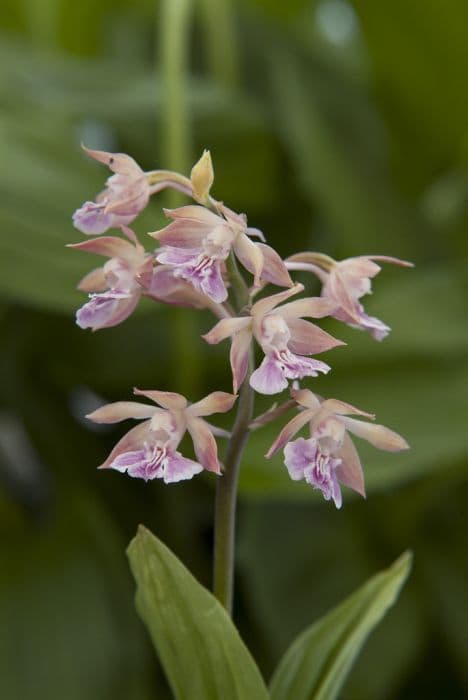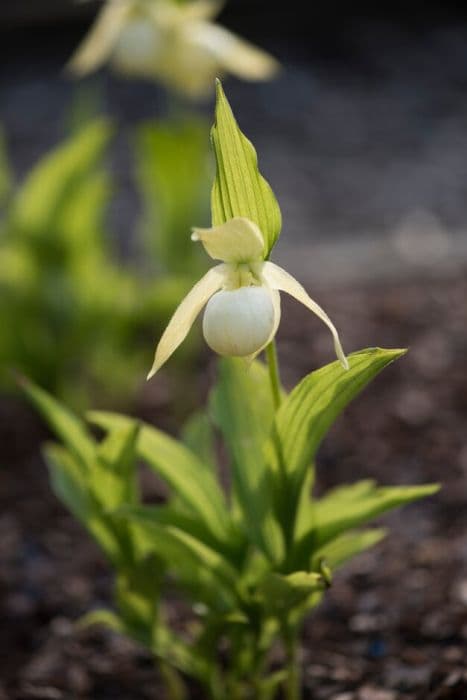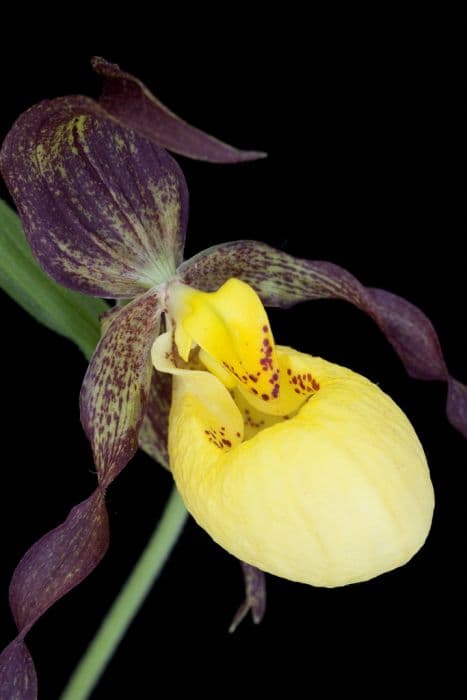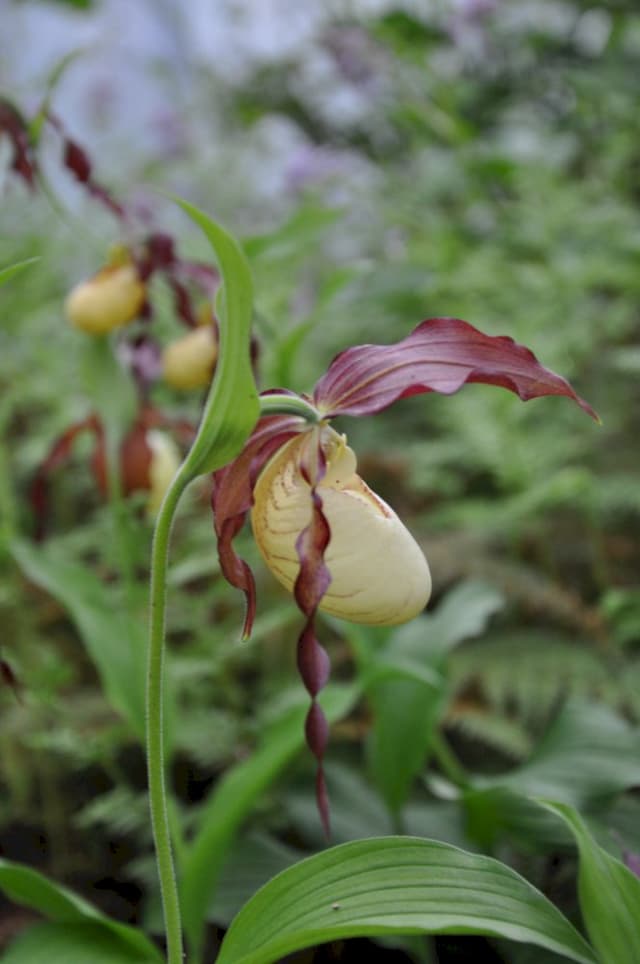Lady's Slipper Orchid Cypripedium Lukas gx

ABOUT
The plant known commonly as the Lady's Slipper Orchid has a striking and distinctive appearance. This variety features a pouch-shaped petal, which is reminiscent of a slipper, thus giving it its common name. The petal's color can range from soft pastels to deep, vivid hues, often featuring an array of mottled patterns or spots. The leaves of the Lady's Slipper Orchid are typically long and narrow, with a rich green color that provides a lush backdrop to the vibrant blossoms. Surrounding the central slipper-like petal are other petals and sepals that may have a different texture or color, sometimes appearing twisted or wavy, adding to the plant's unique and exotic look. The overall effect of the Lady's Slipper Orchid's appearance is one of exotic charm and intricate beauty, making it a highly prized addition to any collection of ornamental plants. Its bloom provides a visual focal point, drawing interest to its unusual structure and stunning coloration.
About this plant
 Names
NamesFamily
Orchidaceae.
Synonyms
Lukas' Lady's Slipper, Hybrid Lady's Slipper.
Common names
Cypripedium Lukas gx.
 Toxicity
ToxicityTo humans
Cypripedium Lukas gx, more commonly known as the Lady's Slipper Orchid, is not known to be toxic to humans. Ingesting any part of the Lady's Slipper Orchid does not typically result in poisoning. Therefore, there are no specific symptoms of poisoning to describe for this plant when it comes to human consumption.
To pets
The Lady's Slipper Orchid, which is the common name for Cypripedium Lukas gx, is not generally listed as toxic to pets. There is little information to suggest that ingestion of this plant by pets would result in poisoning. Consequently, there are no established symptoms of poisoning associated with the Lady's Slipper Orchid for pets. However, it is always important to note that individual animals might react differently, and any ingestion of non-food plants can potentially cause gastrointestinal upset in pets.
 Characteristics
CharacteristicsLife cycle
Perennials
Foliage type
Deciduous
Color of leaves
Green
Flower color
Varies
Height
1-2 feet (30-60 cm)
Spread
1 foot (30 cm)
Plant type
Herb
Hardiness zones
5
Native area
North America
Benefits
 General Benefits
General Benefits- Ornamental Value: Cypripedium Lukas, commonly known as Lady's Slipper Orchid, is prized for its unique and attractive flowers, making it a popular choice for ornamental gardening and landscaping.
- Ecosystem Support: The plant can support local ecosystems, providing food and habitat for pollinators like bees and butterflies.
- Biodiversity: By cultivating the Lady's Slipper Orchid, gardeners can help preserve biodiversity, as it is part of a genus containing many rare and endangered species.
- Education and Research: The Lady's Slipper Orchid can serve as an educational tool to teach about botany, plant ecology, and conservation efforts.
- Cultural Significance: These orchids often have strong cultural relevance and can be used in ceremonies or as symbols within their native regions.
- Garden Aesthetics: Their distinctive appearance can add visual interest and variety to gardens, enhancing the aesthetic appeal of any plant collection.
 Medical Properties
Medical PropertiesThis plant is not used for medical purposes.
 Air-purifying Qualities
Air-purifying QualitiesThis plant is not specifically known for air purifying qualities.
 Other Uses
Other Uses- Lady's Slipper Orchid can be used in terrariums or vivariums, providing a striking visual element and simulating a natural forest environment for small reptiles and amphibians.
- The plant's large, colorful flowers can be used as a natural dye source for fabrics, potentially producing a range of subtle color variations.
- Enthusiasts of traditional handicrafts sometimes incorporate the dried seed pods of the Lady's Slipper Orchid into potpourri mixes for a unique touch.
- Plant photography enthusiasts often seek out Lady's Slipper Orchid due to its distinctive and photogenic appearance, making it a popular subject for botanical photography.
- Beekeepers located near natural populations of the Lady's Slipper Orchid may notice a slightly different taste in their honey, as the orchid can influence the flavor profile.
- Artists can use the complex structure and vibrant colors of Lady's Slipper Orchid as inspiration for botanical illustrations and paintings.
- They are sometimes used in educational settings, like biology classrooms or botanical workshops, to demonstrate plant reproductive strategies and pollination mechanisms.
- Because of its unique appearance, the Lady's Slipper Orchid can serve as a mascot or emblem for botanical gardens and conservation programs focusing on native plant species.
- In floral arrangements for special events, like weddings or banquets, Lady's Slipper Orchids can provide an exotic and luxurious focal point.
- Some people practice the art of ikebana, Japanese flower arranging, using the Lady's Slipper Orchid to add a Western botanical element to this traditional Asian art form.
Interesting Facts
 Feng Shui
Feng ShuiThe Lady Slipper Orchid is not used in Feng Shui practice.
 Zodiac Sign Compitability
Zodiac Sign CompitabilityThe Lady Slipper Orchid is not used in astrology practice.
 Plant Symbolism
Plant Symbolism- Beauty and Elegance: The Cypripedium Lukas gx, commonly known as the Lady's Slipper Orchid, is highly regarded for its unique and striking appearance, symbolizing beauty and elegance in various cultures.
- Resilience and Adaptability: As an orchid able to survive in challenging environments, the Lady's Slipper signifies resilience and the ability to adapt to difficult circumstances.
- Rarity and Value: Due to its rarity and the specific conditions it requires to thrive, the Lady's Slipper Orchid represents something precious and highly valued, much like a rare treasure.
- Femininity and Softness: The characteristic pouch-like shape of the Lady's Slipper flower is reminiscent of a gentle, feminine energy, often symbolizing softness and grace.
- Capriciousness: Because of its specific and sometimes unpredictable growing requirements, the orchid can represent whimsical or capricious behavior, reflecting the complexities of nature.
 Water
WaterLady's slipper orchids like Cypripedium Lukas gx should be watered sparingly to avoid root rot, usually once a week during the active growing season. Ensure the planting medium is slightly damp but not waterlogged. In the dormant season, reduce watering to every other week. Provide about 4 ounces of water per square foot of soil during each watering session, ensuring even distribution across the surface without directly soaking the crown of the plant.
 Light
LightLady's slipper orchids require bright, indirect light to thrive. A spot near a north or east-facing window where they can enjoy the morning light without being exposed to harsh direct sunlight is ideal. They can also tolerate a little direct sun in the early morning or late afternoon, but they should be protected from strong midday sun which can scorch their leaves.
 Temperature
TemperatureLady's slipper orchids prefer a temperature range between 50 to 75 degrees Fahrenheit. They can tolerate a minimum temperature down to 40 degrees Fahrenheit and a maximum up to 80 degrees Fahrenheit. The optimal growing condition is a cool to moderate temperature that replicates their natural woodland habitat, without dramatic fluctuations.
 Pruning
PruningPruning Lady's slipper orchids is primarily focused on removing dead or yellowing leaves and spent flower stems to maintain plant health and appearance. Prune after flowering by cutting the stalk down to the base with sterilized scissors. This should be done annually or as needed when you notice parts of the plant dying back.
 Cleaning
CleaningAs needed
 Soil
SoilLady's Slipper Orchid requires a well-draining soil mix with high organic matter. A mixture of two parts fine pine bark, one part perlite, and one part peat works well. The soil pH should ideally be slightly acidic, around 5.5 to 6.5.
 Repotting
RepottingLady’s Slipper Orchids like Cypripedium Lukas gx should be repotted every 2 to 3 years or when the potting media starts to break down, to prevent root rot and maintain a healthy growing environment.
 Humidity & Misting
Humidity & MistingThe ideal humidity level for a Lady's Slipper Orchid is between 40% and 50%. Keeping the humidity in this range helps mimic the plant's natural environment and ensures healthy growth.
 Suitable locations
Suitable locationsIndoor
Place in bright, indirect light with cool temperatures and good airflow.
Outdoor
Partial shade, shelter from strong winds, and protect from extreme cold.
Hardiness zone
4-8 USDA.
 Life cycle
Life cycleThe Lady's Slipper Orchid (Cypripedium Lukas gx) begins its life as a seed, which is very small and without an endosperm, relying on a symbiotic relationship with mycorrhizal fungi to germinate. Once germinated, the plant enters a juvenile stage, developing its first leaves and a rudimentary root system. Over several years, it will mature slowly, forming a larger, more robust root system and multiple leaves. Upon reaching maturity, which may take several years, it produces its distinct and colorful slipper-shaped flowers during the spring or early summer, which are pollinated by insects. After pollination, the plant will set seed in the form of seed pods, which when mature, will release numerous minute seeds to be dispersed by wind. During the winter or dormant period, the above-ground parts of the plant die back, with the perennial rhizome surviving underground until the next growing season.
 Propogation
PropogationPropogation time
Spring-Early Summer
For the Lady's Slipper orchid (Cypripedium), the most popular means of propagation is by division. This process is usually done in late summer to early fall, just after the plant has finished flowering and when it has started to go dormant. To divide a Lady's Slipper orchid, carefully unearth the plant, ensuring that you maintain as much of the root system as possible. The root clumps should be gently separated by hand or with a knife into smaller sections, each with at least 3-4 growth buds. Once separated, replant the divisions promptly at the same soil depth they were growing at previously, spacing them at least 12 inches (about 30 centimeters) apart to allow for growth. Good drainage and a slightly acidic soil pH are essential for the health of the newly transplanted divisions. Water them in well after planting to help establish the divisions, but be careful not to overwater as this can lead to root rot.









